Kimberley Anglesey's Blog
June 11, 2014
How are fruit trees like editing?
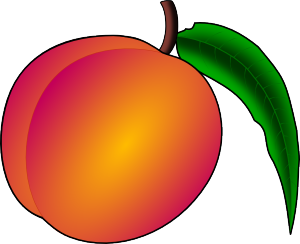 Two years ago I planted a sapling peach tree in my back yard to replace a pear tree that had died. The first spring it produced eleven large, succulent peaches. I fell in love with the tree. The second year a wind storm blew all the blossoms off every tree in my yard and we had no fruit. After a hiatus, this year the trees have come roaring back, loaded down with fruit. Even with the constant wind blowing off tiny pieces, the trees are bending under the weight.
Two years ago I planted a sapling peach tree in my back yard to replace a pear tree that had died. The first spring it produced eleven large, succulent peaches. I fell in love with the tree. The second year a wind storm blew all the blossoms off every tree in my yard and we had no fruit. After a hiatus, this year the trees have come roaring back, loaded down with fruit. Even with the constant wind blowing off tiny pieces, the trees are bending under the weight.
I learned the hard way a tree over burdened with fruit will break. I had a plumb tree split right down the middle, half the tree on the ground. I don’t want to see that happen to my new adolescent peach. So each day I go out and I pinch off pieces of fruit, here and there, checking each cluster and taking away the smaller piece. When the tree has less fruit to manage, the remaining fruit will grow larger and taste better, since the tree doesn’t have to divide its energy as much.
Today while I was thinning the fruit, I thought about how this task was a metaphor for editing my manuscripts. By going through the chapters, sentence by sentence, or branch by branch, and editing out the extraneous words, I am left with a better story.
It’s painful to pinch off beautiful peaches, but it has to be done for the health of the tree. It can also be painful to cut out words that we have labored to write. It also has to be done for the health of the manuscript.
If you’re struggling to decide which words to edit from your story, I recommend a website autocrit.com. This is a fantastic tool for spotting various issues most of us deal with-overused words, repeated words and phrases, sections of passive writing, too much introspection, etc, etc.
March 31, 2014
Drugs, Guns, and Topless Sunbathing
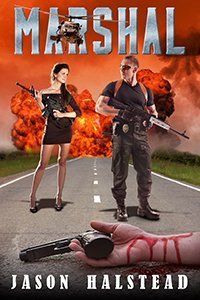 Kimberley was kind enough to offer to share my news of a new release. I’d like to think it has something to do with us having kindred spirits when it comes to trying to help out new writers. Or helping out anyone, for that matter. Whatever the case, I’m appreciative and anxious to get on with my announcement about a new book that I was very excited to write. So, without any more rambling, queue the deep announcer voice: In a world brought to the edge of civilization by terrorism and economic collapse, one man… ah, screw it. That’s too cheesy even for me.
Kimberley was kind enough to offer to share my news of a new release. I’d like to think it has something to do with us having kindred spirits when it comes to trying to help out new writers. Or helping out anyone, for that matter. Whatever the case, I’m appreciative and anxious to get on with my announcement about a new book that I was very excited to write. So, without any more rambling, queue the deep announcer voice: In a world brought to the edge of civilization by terrorism and economic collapse, one man… ah, screw it. That’s too cheesy even for me.
I am very happy to announce the release of Marshal, the fourth book in my Wanted series! Is there terrorism and economic ruin and all that stuff? Sure. But it’s in the past mostly by this point (in other words, read the first three books and start with Wanted – it’s free!). Marshal pits Federal Marshal Carl Waters against some new adversaries that are doing their best to lay the groundwork for an extensive drug, weapons, and human trafficking network throughout the American southwest before the United States government is able to fully reclaim the area.
The excitement doesn’t stop there though. Carl’s daughter, Allison, has followed in his footsteps and used her tech-savvy skills to become a deputy marshal on his team. Jessie (Carl’s Wife) is back and has used her entertainment industry skills to turn herself into a producer as well as an actress.
Tanya Kurkova, billionaire ice princess, and her devoted bounty-hunter turned personal assistant Sarah Gibson are back as well. And wow, are they back. In fact, one of the main plots of the book involves Tanya inheriting the corporate empire from her father. Of course that brings another character out of the past to stir up some trouble. Tanya’s brother, Dustin. The same Dustin that once hoped to have his sister killed so he could become the sole heir.
So Marshal’s got drug dealers, corporate intrigue, romance (including some twisted up love triangles), family struggles, undercover police work, a private pool with clothing optional sunbathing, and some international travel. There’s a lot going on and it’s a lot of fun watching Carl try to maintain his tough guy image while spending time with his daughter and reaching deep to try and offer a more sensitive side to support both friends and family.
January 15, 2014
Inbreeding in California Pumas
Preliminary DNA tests indicate that one male and two female pumas born in the Malibu Springs area were sired by an adult male and his daughter. The reasons for the inbreeding are obvious. Territory for these animals is shrinking and the lands that do remain are boxed in by freeways and urban sprawl. The problem of wild animals cut off from one another is a growing issue across the United States. With farmers and ranchers fencing a great deal of land, the growth of suburbs, and the increase in traffic on the highways, animals struggle to migrate, to reach new territories and to maintain healthy diversity in the gene pool.
Over the years, researchers have found seven mountain lions that were the products of inbreeding. The kittens were healthy but there’s concern that without new blood, eventually inbreeding could cause physical defects, such as heart problems and sterility. The lions live in a patchwork of local, state and federal parkland that stretches westward from Los Angeles into Ventura County. The area is surrounded by densely populated areas and is bounded by such major highways as U.S. 101, which is heavily developed along most of its length.
“There’s almost no place left where there’s natural habitat (along the route) … it’s just a huge barrier for all animals,” said Seth Riley, an urban wildlife expert with the National Park Service. “Young male mountain lions that typically would seek their own territories have been unable to leave and have been killed by an older male. Their movements are totally circumscribed by the freeway.”
One young male was struck and killed by a car in October. The animal crossed eight lanes of roadway but couldn’t jump a 10-foot-high retaining wall topped with chain-link fencing. “That makes this inbreeding more likely than it might otherwise be because the young animals can’t get elsewhere,” Riley said. In addition, other animals cannot easily move into the area from Los Padres National Forest and other neighboring wilderness areas, contributing to low genetic diversity.
Research on the local puma population “shows that conflict with other lions, rodenticide poisoning and vehicle collisions are the top causes of death among more than 30 lions studied. The recreation area, state parks, the Santa Monica Mountains Conservancy, the California Department of Transportation and others have long sought about $10 million in funding to create a wildlife corridor in the Agoura Hills area — essentially, a tunnel that would allow the mountain lions and other animals to cross under U.S. 101.
Clashes between wildlife and humans is hardly a news, and there are no easy answers. I hope that solutions to opening passageways for animals to migrate and spread genetic diversity is taken seriously in all places where wildlife is being boxed in. What do you think?
December 31, 2013
Dolphins who dope
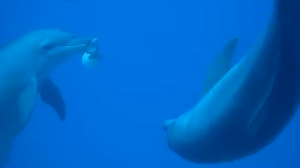 Experts have found evidence that young dolphins purposefully and carefully chew puffer fish to get high.
Experts have found evidence that young dolphins purposefully and carefully chew puffer fish to get high.
The behavior was captured by filmmakers during the creation of the BBC One documentary series Dolphins: Spy in the Pod, which used spy cameras hidden in fake turtles, fish and squid to film more than 900 hours of the aquatic mammals in their natural habitat.
Puffer fish release a toxin that can be deadly in larger amounts, but it can produce a narcotic effect in smaller doses.
Scientists found that dolphins apparently had learned just how much of the toxin would safely intoxicate them, and they carefully chewed the fish and then passed it among themselves.
The dolphins then entered what appeared to be a trance-like state.
“This was a case of young dolphins purposely experimenting with something we know to be intoxicating,” said Rob Pilley, a zoologist who worked as a producer for the series. “After chewing the puffer gently and passing it round, they began acting most peculiarly, hanging around with their noses at the surface as if fascinated by their own reflection.”
Pilley said the behavior was reminiscent of human attempts to seek biological highs.
“It reminded us of that craze a few years ago when people started licking toads to get a buzz, especially the way they hung there in a daze afterwards,” he said. “It was the most extraordinary thing to see.”
The series premiers Thursday, and the “puff-puff-pass” scene will be shown in the second episode.
The documentary makers have previously used similar techniques to record behavior by penguins, lions and elephants.
New Year Resolutions
 It’s the last day of 2013 and many people are putting together their resolutions for the new year. It seems with each passing year, I shuffle my priorities a little. Less stress over being successful and more emphasis on family time and just being happy.
It’s the last day of 2013 and many people are putting together their resolutions for the new year. It seems with each passing year, I shuffle my priorities a little. Less stress over being successful and more emphasis on family time and just being happy.
That’s why this quote I came across resonated with me. It goes like this:
Don’t be fooled.
Success is not the key to happiness.
Happiness is the key to success.
While working hard and chasing our dreams is certainly a part of finding happiness, living each day for the love of family and friends is important and needs to be at the top of my priority list.
Wishing you all a safe and joyous New Year, with family and friends at the top of your list of resolutions.
December 8, 2013
Why History Matters
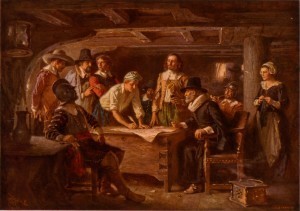 Richard Warren was one of the original pilgrims who arrived on the Mayflower. His daughter, Elisabeth, married Richard Church and had a son, Caleb. Caleb Church married Joanna Sprague, and they had a daughter, Hannah. Hannah Church married Mathew Boomer Jr., and had a son, Caleb Boomer. Caleb married Sarah Martin, and had a son, Mathew Boomer. Mathew married Jane Weld, and had a son, Benjamin Boomer. Benjamin married Mary Collins, and had a son, Jonathan Boomer. Jonathan Boomer married Niobe Franklin, (related to Benjamin Franklin) and they had a son, Jasper Boomer. Jasper married Grace Baker, and they had a son, Holland Baker Boomer. Holland married Loretta J Kelley, and they had my grandmother, Grace Marie Boomer.
Richard Warren was one of the original pilgrims who arrived on the Mayflower. His daughter, Elisabeth, married Richard Church and had a son, Caleb. Caleb Church married Joanna Sprague, and they had a daughter, Hannah. Hannah Church married Mathew Boomer Jr., and had a son, Caleb Boomer. Caleb married Sarah Martin, and had a son, Mathew Boomer. Mathew married Jane Weld, and had a son, Benjamin Boomer. Benjamin married Mary Collins, and had a son, Jonathan Boomer. Jonathan Boomer married Niobe Franklin, (related to Benjamin Franklin) and they had a son, Jasper Boomer. Jasper married Grace Baker, and they had a son, Holland Baker Boomer. Holland married Loretta J Kelley, and they had my grandmother, Grace Marie Boomer.
If I counted correctly, that made 12 generations between me, and Richard Warren. You might be wondering why I would share this information with you. Well, recently I was talking to my oldest son and he said he had not retained much of the history he learned in school, just held it in his head long enough to pass the tests and then promptly forgot the details. He’s 30 years old now and he regrets that he didn’t keep the information in memory. This is something I hear quite often. The problem for many people, in my opinion, is that they don’t feel connected to the history they are learning. They don’t know why they need to learn about things that happened so long ago or what it will do for them as they go through life. It’s all so boring and dry. Doing a little family history research on Ancestry.com showed me just how connected we all are to history. It’s really is just a matter of perspective.
When I write, I do a great deal of research. Often that involves research about historical figures and events, and I weave that information into my books. I hope that anyone reading my work will learn a little something about history and will retain some of that knowledge long after they finish the book. I don’t want to simply entertain, but also educate along the way. I personally happen to be a history buff and love learning about the subject. I’m always stuffing some new history lesson into my head one way or another, reading, documentaries, etc, and I am always happy to learn something I’ve never heard about before. Tonight I learned about the orphan train that sent orphans from the east coast out west, trying to find families for the children suffering neglect in orphanages in the big cities. Somehow that story never came up in school or anything I’ve studied since. I can already imagine a book, or a character, sparked by that little bit of information I learned from a one hour show.
I’m a firm believer in the saying “history repeats itself,” and the adage “if you don’t learn from your mistakes you are doomed to repeat them.” In other words, we have to learn and understand our history in order to make wiser decisions in the future. Considering the state of things, I’d say we really need to brush up on our history and consider those important lessons. But aside from that, history is truly a writer’s best friend. If you’re thinking about becoming a writer, I encourage you to study history! I believe you will find it will not only be a useful tool in developing characters and plots, but will also provide insight into the way the world works and how to use that insight to help you creatively imagine the way the world might turn out in the future. I promise you won’t be wasting your time!
A snippet about Richard Warren:
Among the wealthier of the original Mayflower people Richard Warren was the 12th signer of the Mayflower Compact. This information is from “Families of the Pilgrims: Richard Warren,” second revision, 1986, published by Mass. Society of Mayflower Descendants. It begins as follows: Richard Warren is among the most enigmatic of the pioneers who crossed the Atlantic in 1620 in the Mayflower. Clearly a man of some rank, he was accorded by Governor William Bradford the prefix ‘Mr.,’ pronounced Master, used in those times to distinguish someone because of birth or achievement. From his widow’s subsequent land transactions, we can assume that he was among the wealthier of the original Plymouth settlers.
Nathaniel Morton, a contemporary, commented: This year died Mr. Richard Warren, who was an useful instrument; and during his life bare a deep share in the difficulties and troubles of the first settlement of the Plantation of New-Plimoth.
Imagine now how much more interested I will be in learning about the pilgrims, and their life struggles, now that I know I have a direct ancestral line to one of the first settlers. Perhaps we should all do a little family research and share interesting finds with our children, so they will feel a real connection with the history they study in school, and perhaps retain some of those history lessons long after the test is over.
November 3, 2013
Capture Those Ideas
My grandfather was a private investigator who investigated workers compensation claims. When I was growing up, I would hear him sit in his office and dictate his reports into a tape recorder and then send the tapes to his secretary to be typed.
I often get ideas that come to me about my characters, plot solutions or an idea about how I want to phrase a sentence at odd times when it’s not always possible or convenient to write them down. It might be at night when I am trying to fall asleep, or when I am out for a walk. The next morning, or later in the day after my walk, I’ll remember that I had an idea but can’t recall the details.
With today’s technology, dictation seems like an old fashioned idea, but recently I realized how convenient it would be to have a dictation app when I get an idea for one of my stories. A few months ago I finally upgraded my flip phone to an iPhone. I have to admit, I am not a big app user, I use the standard ones, the calendar and the alarm clock. But the dictation app from Dragon is one I find incredibly useful and recommend to all authors.
The first time I got an idea while I was trying to fall asleep, I opened the app on my phone and dictated the thoughts. It was quite accurate in capturing my words and after I finished dictating I was able to send it to my email. Much faster than typing out an email on the phone. Having the email waiting the next time I went to the computer was a perfect reminder.
Sometimes I want to capture impressions from new experience to use later in my writing. The Dragon Dictation App is the perfect way to note those sensory experiences so I can refer back to them later. You might think you will recall all the nuances of an experience when you visit a new place or try a new hobby. But the truth is, our brains often pick up the highlights and drop the small details.
So when you can’t have a notebook handy, or you just want to get that idea captured before it fades, give the free Dragon Dictation App a try.
October 21, 2013
National Novel Writing Month
 It’s here again, that challenge thrown out to write an entire novel in a single month. Just a rough draft mind you, but daunting nonetheless I know. If you’re not familiar with NoNoWriMo then check out the details http://nanowrimo.org/ I haven’t taken up the challenge myself, not yet, but I’m considering the challenge. I do have a little story in my head that’s crying to make it onto paper, and though it’s not yet in line to be written, I’m thinking I might see if I could whip out the rough draft in November.
It’s here again, that challenge thrown out to write an entire novel in a single month. Just a rough draft mind you, but daunting nonetheless I know. If you’re not familiar with NoNoWriMo then check out the details http://nanowrimo.org/ I haven’t taken up the challenge myself, not yet, but I’m considering the challenge. I do have a little story in my head that’s crying to make it onto paper, and though it’s not yet in line to be written, I’m thinking I might see if I could whip out the rough draft in November.
You know, challenges are good to accept from time to time. They keep us on our toes, make us work hard and help us analyze our progress. Kind of like goal setting. Setting and achieving goals keeps us moving forward.
If you’re new to writing, taking on a challenge like writing a novel in a month might seem like a crazy idea. On the other hand, it might be fun to run the race and see how far you get.
There is a perk for getting involved. Each year, NoNoWriMo authors offer encouraging pep talks to participants. The 2013 authors are James Patterson, Marie Lu, Lev Grossman, Rainbow Rowell, Patrick Rothfuss, Catherynne M. Valente, Bella Andre, Malinda Lo, Holly McGhee, Ralph Peters, and Jeff VanderMeer.
August 27, 2013
SWAG
Recently a book club wrote to me to tell me how much they were enjoying my book, Mer Si Raen Ambush and wanted to know if I had any SWAG I could send to them. The embarrassing answer was no. I had not considered that fans of the book would be asking for a way to commemorate the read for their members. But I assured them that I would get busy and put together some items right away.
Unfamiliar with SWAG for books, I wasn’t sure what people normally offered, beside a bookmark, but a little searching online turned up quite a few opportunities to give fans some items they could purchase, and items that they could download and I even came up with a way to give e-readers something too, in the form of a fan club card. I will sign and mail the cards to anyone who asks.
Not wanting to be caught empty handed a second time, I have been busy creating SWAG items for The Golgotha Covenant, my soon to be released vampire novel. I’m planning to offer desktop wallpapers, and some other assorted goodies.
If you need SWAG for your readers, there are several online resources that have a wide assortment of products.
Café Press
Vista Print
Zazzle
Spreadshirt
Redbubble
Most of these sites allow you to have your own store and sell your items to the general public as well as selling to your fans via your own site. Having graphic design skills is a plus, but if you are hiring your artist, you can arrange with them to provide you with images that you can use to create your SWAG.
Personally, I like to have free items for readers, like bookmarks, wallpapers and things of that nature. But T-shirts sound fun too, and heck, it’s free advertising for your book!
July 24, 2013
Bright Ideas – where do they come from?
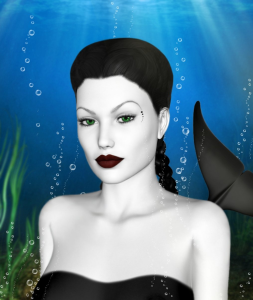
Alari, Queen of the Mer
People often ask me how I come up with the ideas for my novels. I’d love to say that I have a mystical muse who sits on my shoulder whispering in my ear, but aside from the main concept (which often comes in the shower, don’t ask me why) for me, inspiration is three parts research and one part daydreaming. Does that mean there isn’t much creativity to the way I write? Not at all. There’s loads of creativity. But mixing facts into the story can smooth the path through the fictional elements and make things more believable to the reader.
Inspiration can sometimes come from mythology, ancient legends, local folklore. When turning to these sources for ideas, you have to consider that a world of authors have, and continue to, plumb these same sources for inspiration. Spinning an old wives tale into a best seller can certainly be done even today. You only have to look to Laurell K Hamilton, Anne Rice and other top selling authors to know that. But if you’re hoping to find a legend unfamiliar to the public, you’ll likely discover that the idea has been done before, more than once. But don’t fret. Just because it’s been done before doesn’t mean you can’t find a fresh way to spin the tale. This is where the daydreaming comes into play for me. With new characters and your own twist to the concept, you can take a highly familiar monster/story and excite an audience all over again, say the way Twilight did. Don’t be afraid to go where others have trod just because the trail looks too well traveled.
For instance, in my book, Mer Si Raen Ambush, I tell a story about mermaids. There are countless mermaid books on the market. I’m sure you’ve seen a movie or two where they play a staring role. Over done? Maybe. But I had confidence that I could take these highly familiar creatures and make them brand spankin’ new. But before I remade them, I had to know what had been said about them before. That meant I had to learn a thing or two about mermaids.
Something old, something new, something borrowed and something blue doesn’t just apply to weddings. Well, maybe the blue part …
What am I talking about? Here’s an example: Every culture around the globe has it’s own mermaid mythology with unique names for the creatures. While doing my research, I collected those names and then borrowed them for the clan names of my creatures. What’s old is new again. I’m re-writing history, fictionally speaking, by saying that the mermaid clans came first, then humans from different cultures learned these names and used them in their lore. It feels familiar even to people who are not knowledgeable about the mythology, because we all have information lurking in our minds that we don’t remember learning.
So, with all the existing work done on mermaids, how could I write a story about them and make it fresh? Well, I decided the first way to be original was to make my mermaids realistic. Biologically they had to be possible. Instead of half fish and half human, my mermaids are mammals. Aquatic ape is a term recently coined by Animal Planet for this concept. To construct this new mermaid, I had to ask myself a series of questions and those answers drove the storyline.
As an example, my mammalian mermaid breathes air. Where does she sleep then? Do they give birth on land or in the sea? What do these mermaids eat? How do they reproduce? What will their culture be like? Most important, what do they look like?
Here I took a page from nature. Their appearances is like other mammals that live in the sea, some familiar like the orca, and some completely out of my own imagination and some a mix of the two. Pink dolphins inspired my Nixie mermaids. Nixies have pink skin like the dolphin. But from there, I gave Nixies ivory colored hair, blue eyes and a mild disposition and a love of caring for babies. My Nereid mermaids are an orca looking species. They are black and white, with similar skin patterns and their temperament is ferocious, like an orca. I took something real and familiar and wove it into something fictional.
In order for me to write realistically about creatures that live in the ocean, I had to know a lot about that environment. That meant hours of research and a lot of reading, watching documentaries and a commitment to educating myself at every opportunity. Here is a small list of the subjects I studied:
Underwater caves in the ocean.
Sea weed (how it grows, what it’s used for, it’s nutritional qualities, etc.)
How sound travels through water
Whales and dolphins
Sharks
Ocean conservation
Dolphin therapy for healing the sick
The Sargasso sea
The list of other subjects I studied is lengthy. I started in the library, and later was able to make use of the internet – my first book was conceived before the invent of the internet. Crazy hu? Sure the internet is a wonderful research resource, but I also interviewed people, attended lectures, even performed an experiment or two. I read Scientific America, I watch the History Channel, Nat Geo, Through the Wormhole and Dark Science- Twisted but True.
When you write about a subject, it’s important to drill down into the details and know what you’re talking about. I have a military theme in my book. I made sure that my military portions were accurate. Rank, uniforms, protocols and culture. Yes the military has it’s own culture. When those folks read my story they comment on the fact that I did my homework and didn’t screw up the little things that the average person wouldn’t know. That doesn’t happen by accident. I asked veterans to read the book and point out any mistakes I might have made and then I corrected the facts.
Maybe you want to write a fantasy story and make everything up from scratch. Save yourself from all that (sometimes boring) research . . . you’ll find you may still need to do a little study, but in either case, the important thing here is to set up the rules of your fantasy world and then live by them. Your reader will happily follow you wherever you want to take them, as long as you don’t break the rules you established for your world.
Another way I find inspiration is by having QUIET time outside in nature. I am a nature photographer, and I very much enjoy my time behind the lens watching the critters. Not only have I learned a great deal about the animals I observe, but that time that I sit watching them is quiet time to think about story ideas. Even better, I can take those photos and add them to my notebook so that I can have a visual reference when I am writing descriptions later. In a world full of noise, finding quiet places and peaceful moments is a growing challenge. Make it a priority to have a quiet place that inspires your creative thinking.
So here it is in a nut shell. However inspiration normally comes to you, don’t rule out the sparks of creativity that can come from research. You might be surprised what new and entertaining story elements will emerge from doing your homework. And find a place to let your mind wonder and ferment the interesting bits and pieces of information, until a brilliant idea comes bubbling out. Even if it’s not the next story you write, your mind will train itself to take that quiet time and use it for delivering up ideas for your consideration.




